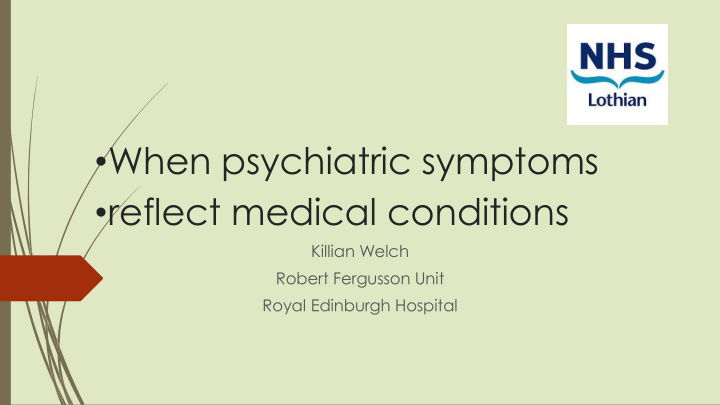



• When psychiatric symptoms • reflect medical conditions Killian Welch Robert Fergusson Unit Royal Edinburgh Hospital
The title is awkward, but dualism is worse! Johnstone E. C. et al. (1976) Cerebral ventricular size and cognitive impairment in chronic schizophrenia Lancet 2:924-926 Mental illness is a metaphor. Minds can be ‘s i ck’ only in the sense that jokes are ‘s i ck’ or economies are ‘ sick. ’
Syndromal diagnoses and associated risk Crude exogenous organic damage of the most varying kind can produce acute psychotic clinical pictures of a basically uniform kind. Karl Bonhoeffer, 1909 Johnson DAW. Evaluation of routine physical examination in psychiatric cases. Practitioner 1968 ; 200 : 686 – 91 .
Focus: Presentations of agitation, emotional disturbance or psychosis not somatic symptom disorder/FND Basic approach: Is the patient delirious? Have they had basic screening? Does it ‘ fit ’ with a psychiatric presentation? Are there ‘ red flags’? Could it be one of the classic ‘ps ychiatric disorder mimics ’ ? What are the care needs of the patient?
1. Exclude delirium Hyperactive: schizophrenia, mania Hypoactive: depression Abrupt onset, altered conscious level, inattention, fluctuating course, circadian rhythm disturbance, visual hallucinations Psychiatric conditions: preserved recent memory and (gross) attention, orientated
2. Adequate history, examination, basic lab screening • Routine Clarify symptoms and onset • screening Collateral history • • F BC • -reluctant to reveal: guarded • U in psychosis &Es • Calcium, • -symptoms unaware of phosphate LFTs (including GGT) TFTs Physical, neurological, • • E mental SR • state and cognitive exam • Gluco se Standard screening • • Urine dipstick, C&S Drug screen
3. Does presentation ‘fit’ with a psychiatric disorder? Gradual onset Expected demographics (onset 15-30) Recurring or relapsing/remitting Grossly preserved cognition Characteristic psychopathology Consistency in dominant symptoms The psychiatri st’s ‘gut feelin g’ Häfner H. Schizophr Res 2005;77:11-24 .
Typical presentations of psychiatric disorders
Schizophrenia Insidious onset Typically late adolescence/early adulthood Orientated, preserved recent memory Normal(ish) attention Thought disorder, but individual sentences coherent Consistent, systematised persecutory delusions Auditory not visual hallucinations Actions understandable(ish) given beliefs
Mania Bipolar Affective Disorder; typical onset adolescence/early adulthood Elevated, irritable mood Grandiose thinking, stable delusions, auditory hallucinations Pressured, ‘ flight of ide as’ rather than ‘con fused ’ Goal directed behaviour Distractible but orientated Sleep disturbance Onset can be subacute Been ‘ latent ’, unipolar for decades ‘ Late onset ’ b ipolar: irritability, vascular disease Hahn C J Geriatric Psychiatry and Neurology 2014, 27: 56-62 ‘ Mixed affective stat e’, ‘man ic deliriu m’
Depression Gradual onset First episode can be older Guilt, hopelessness, suicidality Worse morning rather than night ‘Don’t kn ow’, preser ved(ish) attention/concentration Nihilistic delusions rather visual hallucinations Agitated depression/mixed affective state and severe retardation/catatonia
Personality disorder Personality change as presenting Emotionally Unstable or ‘Borderline’ feature of neurological disease Irritability, rejection sensitivity Enduring patterns of behaviour Demand specific conditions or Agitation/aggression practitioners Agitation when interpersonal conflict/ precipitated by being thwarted expectations not met High propensity suicidal acts Absence major Dissociative states when under stress psychopathology Prone to dissociation and stress- induced quasi-psychotic symptoms
4. Are there any ‘ red flags ’ ? Mode of onset Wrong demographics Wrong symptoms -visual hallucinations -fleeting, changeable delusions Additional evidence brain dysfunction -seizures -motor, sensory, language dysfunction -cognitive deficits Abnormal examination/obs/lab work up e.g. autonomic instability, pyrexia -can they be explained?
Additional investigations Structural imaging HIV and syphilis serology Caeruloplasmin; examine for Kayser – Fleischer rings Thyroid peroxidase Ab ANA, [RF, anti-SSA, anti-SSB, p-ANCA and c-ANCA] EEG: not just to identify epilepsy, encephalopathy Van Der Kooi Arendina W et al. CHEST J 2015 ; 147 : 94 – 101 LP and CSF examination Dopamine transporter scan Functional imaging Synacthen test Genetic testing for Huntingt on’s Multiple sleep latency test; HLA typing; CSF hypocretin levels Ab for limbic encephalitis or genetic testing for FND/MND
5. Classic psychiatric diso rder ‘mi m ics’ Substance intoxication/withdrawal Lewy-body dementia But was diagnosis ‘ wron g’? Huntington ’s disease Depressive prodrome to PD Hydrocephalus Anxiety or FNS in developing FTD Limbic encephalitis Dementia, especially FTD
Two ‘novel’ psychiatric disorder ‘mi m ics’
Limbic encephalitis Ab to neuronal surface ion channels or receptors Movement disorder, seizures, prominent cognitive impairment, autonomic disturbance or treatment resistance Anxiety and psychosis: psychiatry Ab present in ‘ typical ’ presentations of first episode psychosis 3% NMDA serum positive vs. no controls Others did not differ Lennox BR et al Lancet Psychiatry (2017) 4(1):42 – 8. CSF more sensitive than serum for NMDA Ab (15% serum negative) Dalmou J et al Lancet Neurol. 2011;10(1):63 – 74. and more specific for LGI1
Antibodies associated with psychiatric presentations Antibody Presentation NMDA Females (ovarian Irritability, anxiety, insomnia teratoma) Paranoia, delusions, hallucinations Speech dysfunction, orofacial dyskinesias, memory deficits, autonomic instability Decreased consciousness Seizures at any point VGKC Sleep disturbance [LGI1, Amnesia and confusion CAsPR2] Seizures, movement disorders (esp. (thymom faciobrachial dystonic seizures) a, SCLC) Hyponatraemia AMPA Sleep disturbance, hallucinations, (SLC) amnesia, confabulation GABAB Confusion, psychosis, sleep (SCLC) disturbance
Frontotemporal dementia Psychosis most common in C9orf72 and GRN mutations disinhibition/hyperorality/apathy/ personality change (bvFTD) impaired ‘ execu tive’ tests (bvFTD) naming difficulties, poor category fluency (SD) focal frontal/ATL atrophy muscle atrophy/weakness (MND) C9orf72: OCD and psychosis Prato SN et al. Insights Imaging (2015) 6:531 – 544
This is the wrong place for them!! Crucial to treat underlying disorder Crucial patient is kept safe Psychiatric input can help with risk management, environmental and pharmacological interventions Collaboration and imaginative working between general medical/neurology/psychiatric services
Summary Psychiatric symptoms are generally non-specific but disorders often have a characteristic presentation There are not diagnostic tests Correct diagnosis depends on vigilance to key features and exclusion of other possibilities Interdisciplinary working and good communication are central to this Presentations evolve: keep an open mind and be prepared to reassess/reinvestigate We normally get it fairly right!
\ \
Recommend
More recommend